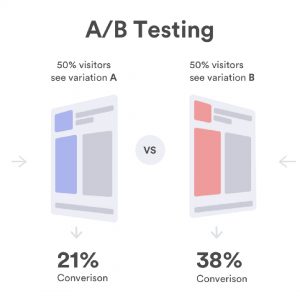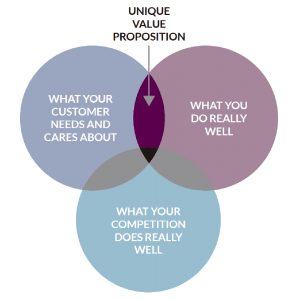A/B Test Marketing to Discover Your Value Proposition in 7 Steps
A/B Testing has become a prevalent technique leveraged by digital marketers to increase conversion rates. AB test marketing signals that any tiny change in imagery or copy on a landing page impacts your customers’ types of actions. The entrepreneurs and campaign marketer team also uses this technique to invalidate or validate experiments on their products and services. It is a compelling approach to make data-backed decisions when creating your design value proposition. Still, similarly, it’s easy to get lost in a rabbit hole of A/B tests if you focus on the wrong techniques or conditions. Infotanks Media discovers your essential value proposition with AB test marketing.
A true value proposition statement is required for every aspect of your business. Look for an example of proposition. And if you already don’t have one, your business is just surviving on pockets of ignorance. Your value proposition is your company’s reason for existing. And it is also the answer to the fundamental customer question:
What is the reason why prospects should choose us over others?
By genuinely asking this question of your company from your customer’s perspective, you’ll eventually get to your employees value proposition – or to the conclusion that you don’t have one. Examine and analyze an example of proposition.
Value proposition statement definition pushes you into the first person. And it would help if you got into the minds of your customer. This is how a savvy campaign marketer produces results. It is not through becoming a guru of landing pages, email, persuasion, etc., those marketers become great. Marketers become great because they study more about customers. They create excellent for the business. Optimization doesn’t happen on the webpage but occurs in the mind. Hence, you must try your best to get into the mind of your ideal prospect when considering your value proposition.
Four other critical factors to remember when understanding the nature of a value proposition:
- A campaign marketer must refine their business’s value proposition statement until it can be articulated in a single, instantly credible sentence. The more concise, the more effective
- A design value proposition is not typically dictated; it is generally discovered. It grows out of the needs of a market. Get a value proposition example.
- Test your design value proposition to evaluate its effectiveness accurately. Effectiveness is measured on how successful your products and services stand to your customers.
- We must avoid a sales-driven approach to product development. A value proposition enables you to develop products and identify the best tools for marketers.
The reality is most of the people legally doing business have an employees value proposition.
We can now go through a 7-step process for testing your value proposition that works for digital marketing campaigns. This is the same 7-step experimentation process that we use when testing value proposition with research partners; it has been patterned after several years of value proposition research.
#1: Reviewing Data
In this step, you are seeking to create context. As described above, a value proposition example can show you how several external factors like competitive offers, customer motivations, etc., affect it. So it must be created within the context of these factors. There are four data points that Infotanks Media uses to develop this context.
- Previous campaigns – How have campaigns been successful in the past? Do you know the best practices of campaign email? Which ones have not? This doesn’t necessarily have to be online campaigns. Anything that can provide insight into your customer’s motivation is a well-accepted data point. If you haven’t already, keep a thorough record of every campaign and test conducted for review and analysis. A campaign marketer can take note of all the activities, including campaign email.
- Demographic data – Aside from unique data about your customers, what can you discover about your industry? What are the general trends? Research has found that millennials open a separate email for brand interaction. So, if your product is an email service, you might want to make the ability to toggle between multiple emails quickly. Make it your value proposition and test in the marketplace to see how forceful that element is of the design value proposition.
- Current metrics – How is your website performing when you monitor the number of website visitors? What landing pages, email messages, products, etc., are generating the most response? How is the website traffic landing on your pages? Which pages are they mostly clicking? Often, such data can give you insights into the intentions of your customers and what they want. A campaign marketer decides the ideal digital marketing campaigns dedicated to each client.
- Competitive analysis – In what way are you behind when compared to your competitors? What makes you different from others? What claims are they making? How do you reach your business with others? Researchers at MECLABS conduct a “Summary Competitive Analysis” on three to five closest competitors. You must understand how you stack up against your competitors. The employees value proposition of competitors gives you a clear understanding of how you can improve.
These four pieces form the background for the next step in testing a value proposition.
#2: Identifying the Ideal Customer
A strong employees value proposition indicates who the company cannot serve and whom it can serve well. And if you don’t focus four value propositions around an ideal customer profile, you risk damaging your value proposition so much that it doesn’t serve anyone.
Step 1 of this process should easily offer you an indication of who that ideal prospect is. Meanwhile, when you create your employees value proposition, it should be with that perfect prospect and only that perfect prospect in mind.
When finding your ideal prospect for your company, you might feel that you have multiple excellent prospects. And the more complex the company, the more accurate this is.
The ideal prospect in your organization’s primary design value proposition is probably an amalgamation of some kind. When you get deeper into launch, you should consider prospect-level value propositions. For example, Why should [Prospect A, Prospect B, Prospect C, etc.] buy from you rather than any of your competitors?. It is derived from the primary value proposition in specific instances.
Now, let’s take a specific example, a reactivation email campaign. Matt Hickman of Yes Lifecycle Marketing suggests that you don’t treat all inactive the same. Instead, He recommends that you analyze subscriber segments and then execute AB test marketing for each segment to find what works best for these different types of prospects. In simple words, each of these segments is a unique prospect type that needs a forceful value proposition. The value proposition for one prospect type may be very different from others and undoubtedly different from people who are not your ideal customer.
#3: Identifying Value Categories
Let us illustrate what we mean with a case study:
CASE STUDY: PPC Value Categories for Major North American Bank
In this case study, one of the banks in North America developed a test to establish which aspect of their small business banking product would be most appealing to its visitors. It wasn’t that their marketing team could not find a value proposition; they could not decide which aspect of their offer would be most valuable to their potential customer.
- Was it a feature?
- Was it a low price?
- Was it customer service?
And the only way to know for sure was to test.
The list of possible fundamental aspects went on, and each of these aspects was converted into a category to test in a search engine ad campaign. Finally, they successfully prioritized seven categories to run the test:
CATEGORY #1: Support
- Expert support available 24/7
CATEGORY #2: Ease
- Ease of access to funds at ATMs
CATEGORY #3: Savings
- The estimated amount of savings
CATEGORY #4: Simplicity
- Reduced work due to payroll services, overdraft protection, and tax filings
CATEGORY #5: Product Design
- Uniquely designed for small businesses that need to give their employees access to accounts
CATEGORY #6: Price
- Low price of monthly fees
CATEGORY #7: Growth
- Potential for growth with credit lines and overdraft protection
#4: Testing Value Proposition in the Channel
Once all the categories were identified, the researchers then started to create succinct expressions carefully. These contain those points of value within the 130-character limit at that time of a pay-per-click (PPC) ad. There are several reasons why we started testing in channels- specifically PPC- before moving on to test the presence of a value proposition on a website. AB testing examples always give you a clear understanding of what to be included while finalizing marketing campaigns. But just for now, it should be satisfying to see some of the ads tested. The Research Partner for this experiment has been anonymized. [Name] displayed as its brand name in the ads).
Overall, all these PPC ads were executed to help identify the value categories that stood out from the rest in achieving user response. In this scenario, the entire team could shortlist the value categories from seven to four, with the winners highlighted above.
Why PPC Is an Excellent Place to Begin Testing Your Value Proposition
PPC is one of the best places to start testing as the price is usually low and the traffic levels are generally higher. For example, you will most likely have many more PPC impressions than product impressions in your conversion process. Hence, when testing five or more than five value proposition treatments, channels enable significant statistical results with much less investment.
It is as if the paid search marketing was developed for Testing of the Value Propositions for three unique reasons:
- Succinctness is forced – Due to the constraints on the number of characters in each line, marketers are forced to craft their value statements tightly. As mentioned above, the most effective Value Propositions are the ones that can be stated briefly. PPC ads force you to do this, and it is one of the best tools for marketers.
- Value is isolated – First, in a PPC ad, you are primarily testing statements of value. Friction is not an issue you can control, nor are there significant anxiety sources at this stage in the process. At the bottom of it all, it’s how you craft a statement of value that determines the effectiveness of a PPC ad.
- Competition is present – And finally, with digital marketing campaigns like PPC, your competition is always a few pixels away, meaning that when running a campaign, you are directly testing your claims of value against your competitors’. Why should your ideal prospect buy from you rather than your competitors? Well, PPC enables your customers to vote directly.
The next set of Testing was focused on integrating the value proposition into the offer pages themselves.
This enabled the team to express a value proposition to the prospects completely. Essentially, the “presentation” is your most strong communication of the value proposition, so the results should be representative of what your visitors find most appealing.
Since you are designing your value proposition treatments for this set of Testing, keep in mind the four elements of force: Exclusivity, Credibility, Appeal, and Clarity.
When executing the test within the channel, you want to clean your expression of each value proposition category with much force as possible.
CASE STUDY: PPC Value Categories for Major North American Bank
Look at the example on the next page; the layout and design stayed the same, with the only change being the offer’s specific messaging. Treatment #1 added the benefits of savings and price. Meanwhile, Treatment #2 added the advantages of simplicity and support.
The conclusion was that the value proposition emphasizing simplicity and support carried the most appeal in the visitor’s mind, achieving a 10% increased conversion rate than the saving and price point of value. This is not to say that the other value points were not crucial to the visitor, only that simplicity and support were the most important in their assessment of the offer’s value.
#6: Analyzing Results
The next step is to interpret the insights applicable to your live marketing campaigns and analyze results. Primarily, you will be finding the most effective expression of value and then integrating it throughout your entire conversion process. While you can be sure that the best performing value proposition can be launched across your online marketing campaigns, you must remember that your value proposition’s appeal will change with time.
This is why you must record the insight understood from the Testing results and start planning for future Testing. When the market evolves, and your competitors change, you will sometimes want to re-evaluate your value proposition.
After all Testing, the team was able to find the key focal point that would receive the highest response from the visitor. And out of all the different value propositions possibilities, one among them outperformed every other: The small business benefit of simplifying banking. The below statement became the “Kernel” for all online marketing initiatives.
Value Proposition Focus:
“The [Name] Small Business Account simplifies small business banking by providing all the tools and resources you need for success.”
Essential Evidentials:
- Designed exclusively to meet the needs of small business
- 24/7 phone access to our dedicated small business advisors
On the other hand, the team that supported this value proposition including evidential- fact-based smaller statements that back up the claims in the value proposition. Meanwhile, this test also helped the researchers find the highest sufficient quantifiable/specific facts that brought credibility to the critical value proposition statement.
In this scenario, a value proposition is not something that you dictate. Instead, it is something that you find. Irrespective of how intuitive your marketing senses are or how many other teammates agree with you, a value proposition cannot be entirely a declaration of marketing. And in the end, it must be tested.
#7: Expressing Your Value Proposition across Digital Properties
Now that we have covered the entire step-by-step process of finding your optimal value proposition, where to next? What do we do once we have seen the optimal value proposition for an offer?
We take it and use it to optimize our digital marketing campaigns across the customer lifecycle and funnel.
This process will take several forms and shapes based on the elements available on your web pages. Although, the research suggests that three common marketing elements integrate a value proposition into a conversion process most effectively:
- Supporting stories
- Evidentials
- Illustrative images
One by one, we will look at examples of these.
Evidential
It is the first out of the three elements of evidential. Essentially, these are codified text bytes that support the claim of value. They are quite evidential, giving support for the claims of value you are making on your web pages.
Once you have found your core value proposition, you will want to find a minimum of three critical evidential that can be used in your copy. As shown below, these usually take the form of bullet points and then include quantifiable and specific language supporting the value. And all the examples below have been used from very successful experiments.
These evidential do not only have to about your product having had evidential about your customers but also that illustrate your value proposition. For example, in an email marketing campaign with Yes Lifecycle Marketing, Marriott International utilized evidential about Marriott Reward member program usage to express the program’s value proposition.
Supporting Stories
The story is the next element that should be used to integrate your value proposition online. The goal here is to find supporting stories that substantiate the claims of value. The value proposition is best expressed and most underutilized in the form of a story. Once you have found your offer’s aspect is most valuable to your audience, start to communicate to your audience how that aspect came about through your company’s story. If you offer unique beers monthly, then talk about how you came to appreciate unique beers and how you go about selecting them. If you are raising money to find a cure for Alzheimer’s, then tell the story of why. Stories create trust, builds the brand, and most importantly, they are highly engaging.
Illustrative Images
Images are the third element that can be used to integrate value proposition online. The objective here is to identify meaningful graphics that clearly illustrate the claim of a value proposition. Usually, the graphics marketers choose brochure fodder and have little to no connection to the value proposition. Although you have found the value category that is most appealing to your ideal prospect, you must find or create images that bring relevance and reality to this value. Turn to some AB testing examples to know how it works. This stands as one of the best tools for marketers.
For example, let’s say your value is a 32-volume set of encyclopedias that you can easily access online, then don’t just show an image of a boy smiling in front of a computer. What does this mean? Instead, use an image that indicates 32 volumes you are getting access to via the computer. This is just one example from many heavy-lifting images.
There are several other ways to integrate your value proposition online. In reality, every element of your web page should be supporting or stating your value proposition in some way. Do an AB test marketing to see what works for you the best.
Although, these three evidential supporting stories and illustrative images are the most effective ways to integrate your value proposition online.
The Bottom Line
The most fundamental aspect of your digital marketing efforts is the value proposition, and hence must be created on something more substantial than gut feeling or internal company polls. Only the best tools for marketers can make this happen. Further, marketers cannot dictate what can only be discovered. Finally, the customer determines the value proposition, not the marketer.
Finding a value proposition is one of the top strategic steps a marketer can take in online marketing. AS described in the details above, finding a value proposition can be achieved in seven steps:
- STEP 1: Reviewing Data
- STEP 2: Identifying the Ideal Customer Profile
- STEP 3: Identifying Core Value Categories
- STEP 4: Testing the Value Proposition in the Channels
- STEP 5: Validating the Value Proposition in the Offer Pages
- STEP 6: Analyzing the Results
- STEP 7: Expressing Your Value Proposition across Your Digital Properties
In conclusion, the process of discovering value propositions might seem like an extra new step that you don’t have time for, but it can be done relatively in less time with the process outlined in this article. Utilize the best tools for marketers and carry out AB test marketing for every campaign. Further, when you realize how much time marketers waste swinging the dull blade of an unappealing value proposition, you will find it worthwhile to spend the extra hour doing a little sharpening.














Write A Comment